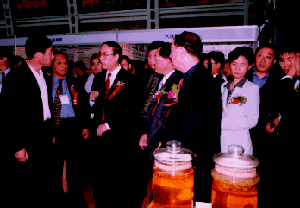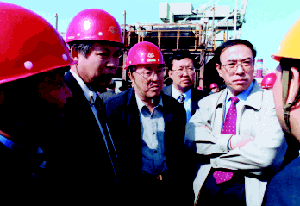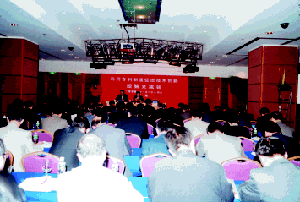V. Patent Administration
1. Coordination
From February 1 to July 31,2000, SIPO initiated a half year anticounterfeiting program, in cooperation with the Ministry of Foreign Trade and Economic Cooperation, the General Administration of Customs, the State Administration for Industry & Commerce, and the State Administration for Entry-Exit Inspection and Quarantine, in order to attack the counterfeited UL certification marks, improve the reputation of Chinese exported products, promote exports, and safeguard the national interests and consumers. As a result, the program had achieved favorable effects, showing the resolution and confidence of the Government to fight against the counterfeited acts and maintain the normal trade order.
The local intellectual property offices or supervision and coordination authorities had been active in their role of undertaking the obligation of coordination by working with other agencies to formulate an effective scheme and taking into account the advantage of different agencies, as a result of which severely attacked the counterfeited activities and punished persons involved. The statistics show that, under the supervision of the authorities for entry-exit inspection and quarantine, 2,000,000 RMB worthy of counterfeited UL certification marks were destroyed, together with fine of 800,000 RMB.10 cases were transferred to the administrations for industry and commerce and the Police. Local Customs offices initiated investigation on 80 batches of exported products with counterfeited UL certification marks, of which 29 were involved in the counterfeited UL certification marks worthy of $2,300,000. The administrations for industry and commerce investigated into the 10 cases and handled one case with a fine of 30,000RMB.
2.Formulation and Implementation of the "Implementing Plans for the Fulfillment of President Jiang Zemin's Important Instructions on Intellectual Property "
In order to carry out President Jiang's instructions and to pilot the patent administration of agencies and industries, SIPO formulated "Implementing Plans for the Fulfillment of President Jiang Zemin's Important Instructions on Intellectual Property". It clearly defined the 12 agencies and corporations as the major implementing agencies including the Ministry of Information Industry. In addition, a meeting was organized for participants to study the instructions and conduct self-review activities. All the concerned agencies paid great attention to the plans and worked out blue prints and actively got involved themselves in the self-review activities in accordance with requirements of the implementing plans. As a result, it promoted the development of patent work within concerned departments and ministries as well as corporations.
3.Patent Strategy Research for Major Technical Areas
Based upon the policy of the national industrial development and the importance of science and technology, 4 technical areas such as gene, photoelectricity, Chinese medicine and nano technology were selected to be the object of patent strategy research. Those areas, in which China owned a comparative advantage and a promising market, were expected to engender new economic growth. Projects were established on the basis of research, and the competent authorities, with which research schemes were formulated, were decided. The midterm report was finished before the end of the year.
At the same time, calculations and analyses were made on the patent applications from Kodak Company and Fuji Company to provide referential statistics for the development of Chinese enterprises.
"Research on Macroscopic Patent Strategy Curve" was edited and published in the year.
4.Patent work in High and New Technologies Development Zones
In order to strengthen the patent administration in High and New Technology Development Zone, and to promote the innovation system in the zones, SIPO and Beijing Intellectual Property Office carried out the study and research on the patent affairs in Zhongguancun Technology Zone and provided strategic advice. Moreover, researches were done on the establishment of a patent zone in Huludao City, Liaoning Province, a Model Zone for the Industrialization of Patented Technologies in Deyang City, Sichuan Province, and trial project for patent in Yangiing Model Zone for the Industrialization of High and New Agricultural Technologies in Shaanxi. SIPO already approved to establish the Model Zone for the Industrialization of Patented Technologies in Deyang City, Sichuan Province, and started patent trial project in Yangling Model Zone for the Industrialization of High and New Agricultural Technologies in Shaanxi Province.
5.Model Projects for the Industrialization of Patented Technologies
This year, SIPO examined 34 model projects for the industrialization of patented technologies, of which 23 were accepted as qualified. These 23 projects saw an annual sale of 4 billion RMB from January 1999 to March 2000, making a revenue of 0.9 billion RMB and export income of $98,000,000. Meanwhile, the second phase of Selection for Model Projects for the Industrialization of Patented Technologies was started and 47 were chosen as candidates. By now, these 47 projects had earned a total sale of 89.7 billion RMB, of which 13 billion were made by use of patented technologies, worth $17,000,000.
To promote the development of the model projects for the industrialization of patented technologies, the Office co-organized with Liaoning provincial government the "Year 2000 National Fair on the Industrialization of Patented Technologies" in September. And in December, the Office co-organized with the Economic Daily the "Seminar on Patent Industrialization-New Business". In 2000, 141 model projects were launched by SIPO for purpose of the industrialization of patented technologies, either under the management of the Office or of local patent administrative authorities. These projects played important demonstrative roles in developing high and new technologies, accelerating technical innovations, and achieving industrialization.


The left picture: On Septermber 26, the SIPO organized in Shenyang city, jointly with the Liaoning provincial government, the Year 2000 National Fair on Industrialization of Patented Technologies. Mr Wang Jingchuan (third from the left in the front line), talking with inventors after the opening ceremony.
The right picture: During the Conference on Exchange of Experiences in Applying the Patent System to Technical Innovation, leaders of SIPO visited Baoshan Steel Group in Shanghai. Mr.Wang Jingchuan (second from the right in the front line), Mr Yang Zhengwu (third from the right in the first line) and Mr Wu Boming (forth from the right in the front line) held discussion with employees of the enterprise.
6.Administration of Patent Contracts and Issuance of Certificates for Advertisement of Patents
Registration of patent mortgage contracts: in the year 2000, the Office received 14 registrations for mortgages on patent rights, of which there was mortgage worth of 700,000,000 RMB, debts 300,000,000 RMB, foreign currency mortgage $3billiion. The mortgage contracts for patent rights increased by 20% as compared with that of 1999.
Registration of patent licensing contracts: In 2000, SIPO received 109 registrations for patent licensing contracts, an increase of 550% over 1999.
Issuance of Certificates for Advertisement of Patents: In 2000, 129 certificates were issued for advertisement of patent by SIPO. 253 certificates were issued by the intellectual property administrative authorities of local provinces, autonomous regions, municipality directly under the Central government and cities specifically designated in the state plan. The total number issued increased by 63%, compared with that of 1999.
7.Patent Trial Enterprises
In cooperation with State Commission for Economy and Trade, the Office formulated and promulgated the "Regulations for the Administration of Patent Work in Enterprises". 70 enterprises were then examined, of which 21 were chosen including Huawei as the experimental subjects which can be looked at as model. At the same time, a new phase of patent work in trial enterprises was started.
8.Patent Asset Evaluation
The Office finished the program of "Parameters for Patent Asset Evaluation and Standard," and initiated the research on Manual of Patent Asset Evaluation.
9.Patent Trial Cities
The office held the yearly Working Conference on Patent Work in Trial Cities. Present at the conference were mayors from 11 trial cities and leading officials of local patent administrative agencies. Mr. Wang Jingchuan made a speech at the conference. Based on the Office's "Guidelines for Promoting the Patent Work in Technological Trial Cities" and the working schemes of the cities, participants summarized on what had done in the past, exchanged their experience, analyzed the present problems to be solved, proposed countermeasures, and deployed arrangement for the next phase. Arrangements for those newly added western trial cities were also made according to the Western Development Plan. The conference made necessary preparations for the "Conference on Exchange of Experiences in Applying the Patent System to Technical Innovation".
From 2nd-4th November, the SIPO convened in Shanghai the Conference on Exchange of New Experiences in Applying the Patent System to Technical Innovation.Leaders from 18 provinces (autonomous regions and municipalities) attended the conference.
Based on recommendations by patent administrative authorities of western provinces and applications from concerned municipal governments and after field research and analysis, the Office decided to add Baotou and Guiyang into the list of the trial cities. Now there are 13 such cities in different regions with various industry structure including Wuhan, Xi'an, Shijiazhuang, Xiamen, Mianyang, Xiangtan, Yanbian, Zhaoyuan, Wujin, Shangyu, Chenghai. In the year, the patent work in trial cities was progressing as planned under the guidance and supervision of the Office. An atmosphere was formed where there was support from the leading municipal officials, cooperation among the concerned authorities, active involvement by enterprises and comprehensive coordination by the patent administrative authorities. Each city formulated and implemented the scheme and set up a working team headed by vice majors. Each city contributed its efforts and had made significant progress and positive effects with regard to the applications, enforcement, industrialization, or construction.
2013-07-17 Print
Print
